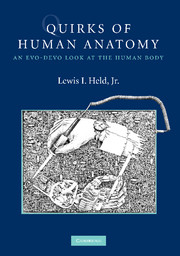Book contents
- Frontmatter
- Contents
- Preface
- CHAPTER 1 BACKGROUND
- CHAPTER 2 SYMMETRY AND ASYMMETRY
- CHAPTER 3 MYSTERIES OF THE MIDLINE
- CHAPTER 4 MERISM AND MODULARITY
- CHAPTER 5 SEXUAL DIMORPHISMS
- CHAPTER 6 SILLY, STUPID, AND DANGEROUS QUIRKS
- CHAPTER 7 MIND AND BRAIN
- EPILOGUE
- APPENDIX: QUIRKS OF HUMAN BEHAVIOR
- References
- Index
CHAPTER 4 - MERISM AND MODULARITY
Published online by Cambridge University Press: 05 August 2012
- Frontmatter
- Contents
- Preface
- CHAPTER 1 BACKGROUND
- CHAPTER 2 SYMMETRY AND ASYMMETRY
- CHAPTER 3 MYSTERIES OF THE MIDLINE
- CHAPTER 4 MERISM AND MODULARITY
- CHAPTER 5 SEXUAL DIMORPHISMS
- CHAPTER 6 SILLY, STUPID, AND DANGEROUS QUIRKS
- CHAPTER 7 MIND AND BRAIN
- EPILOGUE
- APPENDIX: QUIRKS OF HUMAN BEHAVIOR
- References
- Index
Summary
The first part of your body you saw as a baby was a hand as it flitted in front of your face. You may not have noticed it at the time, but those five digits are quite similar to one another. Later, you discovered that five comparable things protrude from each foot. Our 20 fingers and toes are all variations on the theme of a digit module. Indeed, modularity itself is a theme throughout our body [277, 2300, 2303]. Other examples include our spine, which has 33 vertebrae (12 with ribs), and our mouth, which sprouts 32 (adult) teeth. In each case, the units are arranged serially and spaced regularly. In short, they are meristic [151].
Spatial periodicity is a ubiquitous feature of living things [383], and it has been studied extensively in embryology [2777]. Periodic patterns can be made in various ways, depending on the species and the body part [1102, 1135, 1724].
What makes the thumb our only opposable digit?
Our fingers are virtually indistinguishable when they are first detectable as protrusions from the edge of our palm [452,1638]. Later, differences are imposed on them [1872, 1950, 2605] by two “morphogens” (molecules that inform cells about their positions [2542]): “Sonic hedgehog” (Shh) [1985] and “Bone Morphogenetic Protein” (BMP: types 2, 4, and 7) [1889]. Shh is produced near the pinkie and diffuses as far as the forefinger [1244, 2252], so that its concentration tapers to form a gradient (Fig. 4.1a) [148,1483].One effect of this gradient is to reliably make five digits [844, 1557].
The cells between the digits assess their level of Shh [555, 2621, 2910]—apparently by integrating their exposure over time [1704, 2193, 2292]—and secrete a proportional dose of BMP [2535].
- Type
- Chapter
- Information
- Quirks of Human AnatomyAn Evo-Devo Look at the Human Body, pp. 49 - 74Publisher: Cambridge University PressPrint publication year: 2009
- 1
- Cited by



